Rupert Matthews's Blog, page 18
July 25, 2016
On this day in history 27 July 1945 Birth of Geoffrey de Havilland, British aircraft engineer
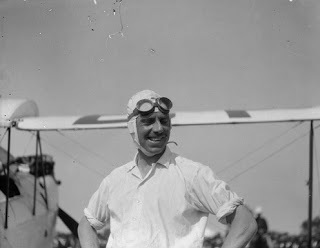 On this day in history
On this day in history27 July 1945
Birth of Geoffrey de Havilland, British aircraft engineer
Captain Sir Geoffrey de Havilland OM CBE AFC RDI FRAeS (27 July 1882 – 21 May 1965) was a British aviation pioneer and aircraft engineer. His Mosquito has been considered the most versatile warplane ever built, and his Comet was the first jet airliner to go into production.
Built with money borrowed from his maternal grandfather,[1] de Havilland's first aircraft took two years to build before he crashed it during its first very short flight at Seven Barrows near Litchfield, Hampshire in December 1909.[2] He built a fresh biplane, making his first flight in it from a meadow near Newbury in September 1910.[3] A memorial plaque presently marks the event. Subsequent designs were even more successful: in 1912 he established a new British altitude record of 10,500 feet (3.2 km) in an aircraft of his design, the B.E.2. Geoffrey was the designer and his brother Hereward was the test pilot.
In December 1910, de Havilland joined HM Balloon Factory at Farnborough, which was to become the Royal Aircraft Factory. He sold his second aeroplane (which he had used to teach himself to fly) to his new employer for £400. It became the F.E.1, the first aircraft to bear an official Royal Aircraft Factory designation. For the next three years de Havilland designed, or participated in the design of, a number of experimental types at the "Factory".
In January 1914, de Havilland was appointed an inspector of aircraft for the Aeronautical Inspection Directorate. Unhappy at leaving design work, in May he was recruited to become the chief designer at Airco, in Hendon. He designed many aircraft for Airco, all designated by his initials, DH. Large numbers of de Havilland-designed aircraft were used during the First World War, flown by the Royal Flying Corps and later the Royal Air Force.
Airco was bought by the BSA Company, but BSA was interested only in using the company factories for car production. Raising £20,000, de Havilland bought the relevant assets and in 1920 formed the de Havilland Aircraft Company at Stag Lane Aerodrome, Edgware, where he and his company designed and built a large number of aircraft, including the Moth family. In 1933 the company moved to Hatfield Aerodrome, in Hertfordshire. One of his roles was as test pilot for the company's aircraft. He was believed to have said "we could have had jets" in reference to the ignoring of jet engine possibilities prior to the start of the 1939–45 world war. His company's aircraft, particularly the Mosquito, played a formidable role in that war. In 1944 he bought out his friend and engine designer Frank Halfords engine design consultancy company, forming the de Havilland Engine Company with Halford as head. Halford had previously designed a number of engines for de Havilland, including the de Havilland Gipsy and de Havilland Gipsy Major. Halford's first gas turbine design entered production as the de Havilland Goblin powering de Havilland's first jet, the Vampire.
De Havilland controlled the company until it was bought by the Hawker Siddeley Company in 1960.
Retirement and death.

Published on July 25, 2016 01:21
On this day in history 26 July 1945 HMS Vestal is last British ship sunk in World War 2
On this day in history
26 July 1945
HMS Vestal is last British ship sunk in World War 2
HMS Vestal was an Algerine-class minesweeper of the Royal Navy. She was launched in 1943 and saw service in the Pacific War against the Empire of Japan. She was critically damaged by Japanese kamikaze aircraft in 1945 and was subsequently scuttled in waters close to Thailand.
Vestal was deployed as a part of the East Indies Fleet, along with Pincher, Plucky, Recruit, Pickle, Rifleman, and Chameleon. On 24 July, Squirrel hit a mine, which killed seven men. The ship was scuttled by Rotherham, and the survivors were rescued by Vestal, and taken to the battleship Nelson.
Vestal was sunk on 26 July 1945 whilst participating in Operation Livery. At around 18:25, an alarm was sounded as three unidentified planes had been spotted coming over Phuket Island, and were soon followed by several more. Vestal was hit by a kamikaze, sustaining critical damage. She was the last Royal Navy ship to be sunk in the Second World War. As the ship was hit close to Thailand, which was a Japanese held territory, the crew were taken off and the ship was scuttled.
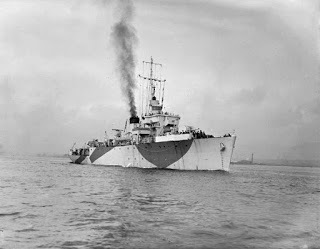

26 July 1945
HMS Vestal is last British ship sunk in World War 2
HMS Vestal was an Algerine-class minesweeper of the Royal Navy. She was launched in 1943 and saw service in the Pacific War against the Empire of Japan. She was critically damaged by Japanese kamikaze aircraft in 1945 and was subsequently scuttled in waters close to Thailand.
Vestal was deployed as a part of the East Indies Fleet, along with Pincher, Plucky, Recruit, Pickle, Rifleman, and Chameleon. On 24 July, Squirrel hit a mine, which killed seven men. The ship was scuttled by Rotherham, and the survivors were rescued by Vestal, and taken to the battleship Nelson.
Vestal was sunk on 26 July 1945 whilst participating in Operation Livery. At around 18:25, an alarm was sounded as three unidentified planes had been spotted coming over Phuket Island, and were soon followed by several more. Vestal was hit by a kamikaze, sustaining critical damage. She was the last Royal Navy ship to be sunk in the Second World War. As the ship was hit close to Thailand, which was a Japanese held territory, the crew were taken off and the ship was scuttled.


Published on July 25, 2016 01:14
On this day in history 25 July 315 Completion of the Arch of Constantine, Rome
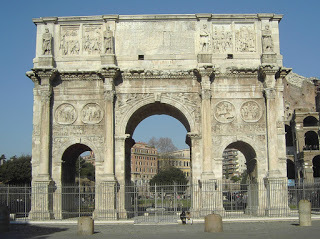 On this day in history
On this day in history25 July 315
Completion of the Arch of Constantine, Rome
The Arch of Constantine (Italian: Arco di Costantino) is a triumphal arch in Rome, situated between the Colosseum and the Palatine Hill. It was erected by the Roman Senate to commemorate Constantine I's victory over Maxentius at the Battle of Milvian Bridge in 312.[a] Dedicated in 315, it is the largest Roman triumphal arch.[1] The arch spans the Via triumphalis, the way taken by the emperors when they entered the city in triumph.
Though dedicated to Constantine, much of the decorative material incorporated earlier work from the time of the emperors Trajan (98–117), Hadrian (117–138) and Marcus Aurelius (161–180), and is thus a collage.[2] The last of the existing triumphal arches in Rome, it is also the only one to make extensive use of spolia,[3] reusing several major reliefs from 2nd century imperial monuments, which give a striking and famous stylistic contrast to the sculpture newly created for the arch. This earned it the derisive nickname of Cornacchia di Esopo Aesop's Crow.[4]
The arch is 21 m high, 25.9 m wide and 7.4 m deep. It has three archways, the central one being 11.5 m high and 6.5 m wide and the lateral archways 7.4 m by 3.4 m each. Above the archways is placed the attic, composed of brickwork reveted (faced) with marble. A staircase within the arch is entered from a door at some height from the ground, on the west side, facing the Palatine Hill. The general design with a main part structured by detached columns and an attic with the main inscription above is modelled after the example of the Arch of Septimius Severus on the Roman Forum.

Published on July 25, 2016 01:09
July 18, 2016
On this day in history 22 July 1844 Birth of William Spooner
On this day in history
22 July 1844
Birth of William Spooner
William Archibald Spooner (22 July 1844 – 29 August 1930) was a long-serving Oxford don, notable for absent-mindedness, and supposedly liable to mix up the syllables in a spoken phrase, with unintentionally comic effect. Such phrases became known as spoonerisms, and are often used humorously. Many spoonerisms have been invented and attributed to Spooner.
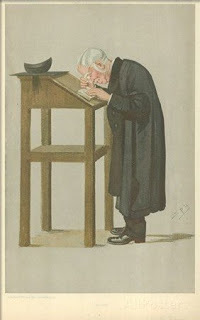
Spooner has become famous for his (real or alleged) "spoonerisms", plays on words in which corresponding consonants, vowels, or morphemes are switched. Few, if any, of his own spoonerisms were deliberate, and many of those attributed to him are apocryphal. Spooner is said to have disliked the reputation gained for getting his words muddled.
The Oxford Dictionary of Quotations (3rd edition, 1979) lists only one substantiated spoonerism: "The weight of rages will press hard upon the employer." In a 1930 interview, Spooner himself admitted to uttering "Kinkering Congs Their Titles Take" (Conquering Kings...) Spooner called this hymn out from the pulpit in 1879.
Many other quotations, "probable and improbable, were invented" and attributed to Spooner, including:
"It is kisstomary to cuss the bride" (...customary to kiss the bride)
"I am tired of addressing beery wenches" (weary benches)
"Mardon me padam, this pie is occupewed. Can I sew you to another sheet?" (Pardon me, madam, this pew is occupied. Can I show you to another seat?)
"You have hissed all my mystery lectures, and were caught fighting a liar in the quad. Having tasted two worms, you will leave by the next town drain" (You have missed all my history lectures, and were caught lighting a fire in the quad. Having wasted two terms, you will leave by the next down train)
Spooner is supposed to have committed other absent-minded gaffes. He was said to have invited a don to tea, "to welcome Stanley Casson, our new archaeology Fellow". "But, sir," the man replied, "I am Stanley Casson". "Never mind," Spooner said, "Come all the same."
On his death, The Times recorded that "He was not afraid of conversation."
22 July 1844
Birth of William Spooner
William Archibald Spooner (22 July 1844 – 29 August 1930) was a long-serving Oxford don, notable for absent-mindedness, and supposedly liable to mix up the syllables in a spoken phrase, with unintentionally comic effect. Such phrases became known as spoonerisms, and are often used humorously. Many spoonerisms have been invented and attributed to Spooner.

Spooner has become famous for his (real or alleged) "spoonerisms", plays on words in which corresponding consonants, vowels, or morphemes are switched. Few, if any, of his own spoonerisms were deliberate, and many of those attributed to him are apocryphal. Spooner is said to have disliked the reputation gained for getting his words muddled.
The Oxford Dictionary of Quotations (3rd edition, 1979) lists only one substantiated spoonerism: "The weight of rages will press hard upon the employer." In a 1930 interview, Spooner himself admitted to uttering "Kinkering Congs Their Titles Take" (Conquering Kings...) Spooner called this hymn out from the pulpit in 1879.
Many other quotations, "probable and improbable, were invented" and attributed to Spooner, including:
"It is kisstomary to cuss the bride" (...customary to kiss the bride)
"I am tired of addressing beery wenches" (weary benches)
"Mardon me padam, this pie is occupewed. Can I sew you to another sheet?" (Pardon me, madam, this pew is occupied. Can I show you to another seat?)
"You have hissed all my mystery lectures, and were caught fighting a liar in the quad. Having tasted two worms, you will leave by the next town drain" (You have missed all my history lectures, and were caught lighting a fire in the quad. Having wasted two terms, you will leave by the next down train)
Spooner is supposed to have committed other absent-minded gaffes. He was said to have invited a don to tea, "to welcome Stanley Casson, our new archaeology Fellow". "But, sir," the man replied, "I am Stanley Casson". "Never mind," Spooner said, "Come all the same."
On his death, The Times recorded that "He was not afraid of conversation."

Published on July 18, 2016 01:59
On this day in history 21 July 1861 First Battle of Bull Run (Manassas)
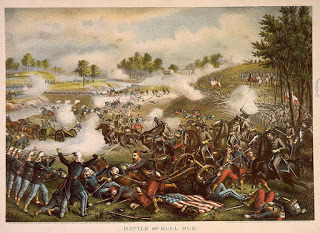 On this day in history
On this day in history21 July 1861
First Battle of Bull Run (Manassas)
The First Battle of Bull Run, also known as Battle of First Manassas (the name used by Confederate forces), was fought on July 21, 1861 in Prince William County, Virginia, near the city of Manassas, not far from Washington, D.C. It was the first major battle of the American Civil War. The Union's forces were slow in positioning themselves, allowing Confederate reinforcements time to arrive by rail. Each side had about 18,000 poorly trained and poorly led troops in their first battle. It was a Confederate victory followed by a disorganized retreat of the Union forces.
Just months after the start of the war at Fort Sumter, the Northern public clamored for a march against the Confederate capital of Richmond, Virginia, which they expected to bring an early end to the rebellion. Yielding to political pressure, Brig. Gen. Irvin McDowell led his unseasoned Union Army across Bull Run against the equally inexperienced Confederate Army of Brig. Gen. P. G. T. Beauregard camped near Manassas Junction. McDowell's ambitious plan for a surprise flank attack on the Confederate left was poorly executed by his officers and men; nevertheless, the Confederates, who had been planning to attack the Union left flank, found themselves at an initial disadvantage.
Confederate reinforcements under Brig. Gen. Joseph E. Johnston arrived from the Shenandoah Valley by railroad and the course of the battle quickly changed. A brigade of Virginians under the relatively unknown brigadier general from the Virginia Military Institute, Thomas J. Jackson, stood their ground and Jackson received his famous nickname, "Stonewall Jackson". The Confederates launched a strong counterattack, and as the Union troops began withdrawing under fire, many panicked and the retreat turned into a rout. McDowell's men frantically ran without order in the direction of Washington, D.C.
Both armies were sobered by the fierce fighting and many casualties, and realized the war was going to be much longer and bloodier than either had anticipated, and not the short conflict that had been expected. The Battle of First Bull Run highlighted many of the problems and deficiencies that were typical of the first year of the war. Units were committed piecemeal, attacks were frontal, infantry failed to protect exposed artillery, tactical intelligence was nil, and neither commander was able to employ his whole force effectively. McDowell, with 35,000 men, was only able to commit about 18,000, and the combined Confederate forces, with about 32,000 men, committed only 18,000.

Published on July 18, 2016 01:53
On this day in history 20 July 1804 Birth of Richard Owen, paleontologist
On this day in history
20 July 1804
Birth of Richard Owen, paleontologist
Sir Richard Owen KCB FRS (20 July 1804 – 18 December 1892) was an English biologist, comparative anatomist and paleontologist. Despite being a controversial figure, Owen is generally considered to have been an outstanding naturalist with a remarkable gift for interpreting fossils.
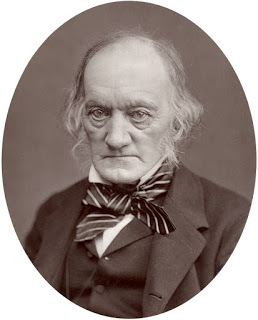
Owen produced a vast array of scientific work, but is probably best remembered today for coining the word Dinosauria (meaning "Terrible Reptile" or "Fearfully Great Reptile"). Owen was an outspoken critic of Charles Darwin's theory of evolution by natural selection. He agreed with Darwin that evolution occurred, but thought it was more complex than outlined in Darwin's On the Origin of Species. Owen's approach to evolution can be seen as having anticipated the issues that have gained greater attention with the recent emergence of evolutionary developmental biology.
Owen also campaigned for the natural specimens in the British Museum to be given a new home. This resulted in the establishment, in 1881, of the now world-famous Natural History Museum in South Kensington, London. Bill Bryson argues that, "by making the Natural History Museum an institution for everyone, Owen transformed our expectations of what museums are for".
His contributions to science and public learning notwithstanding, Owen's driving ambition, occasionally vicious temperament, and determination to succeed meant that he was not always popular with his fellow scientists. Owen was feared and even hated by some contemporaries such as Thomas Henry Huxley. His later career was tainted by a number of controversies, many of which involved accusations that he took credit for other people's work.

20 July 1804
Birth of Richard Owen, paleontologist
Sir Richard Owen KCB FRS (20 July 1804 – 18 December 1892) was an English biologist, comparative anatomist and paleontologist. Despite being a controversial figure, Owen is generally considered to have been an outstanding naturalist with a remarkable gift for interpreting fossils.

Owen produced a vast array of scientific work, but is probably best remembered today for coining the word Dinosauria (meaning "Terrible Reptile" or "Fearfully Great Reptile"). Owen was an outspoken critic of Charles Darwin's theory of evolution by natural selection. He agreed with Darwin that evolution occurred, but thought it was more complex than outlined in Darwin's On the Origin of Species. Owen's approach to evolution can be seen as having anticipated the issues that have gained greater attention with the recent emergence of evolutionary developmental biology.
Owen also campaigned for the natural specimens in the British Museum to be given a new home. This resulted in the establishment, in 1881, of the now world-famous Natural History Museum in South Kensington, London. Bill Bryson argues that, "by making the Natural History Museum an institution for everyone, Owen transformed our expectations of what museums are for".
His contributions to science and public learning notwithstanding, Owen's driving ambition, occasionally vicious temperament, and determination to succeed meant that he was not always popular with his fellow scientists. Owen was feared and even hated by some contemporaries such as Thomas Henry Huxley. His later career was tainted by a number of controversies, many of which involved accusations that he took credit for other people's work.

Published on July 18, 2016 01:49
On this day in history 19 July 2014 Death of James Garner, actor
On this day in history
19 July 2014
Death of James Garner, actor
James Garner (born James Scott Bumgarner; April 7, 1928 – July 19, 2014) was an American actor, producer, and voice artist. He starred in several television series over more than 5 decades, including such popular roles as Bret Maverick in the 1950s western comedy series Maverick and Jim Rockford in The Rockford Files, and played leading roles in more than 50 theatrical films, including The Great Escape (1963) with Steve McQueen, Paddy Chayefsky's The Americanization of Emily (1964), Grand Prix (1966), Blake Edwards' Victor Victoria (1982), Murphy's Romance (1985), for which he received an Academy Award nomination, Space Cowboys (2000) with Clint Eastwood, and The Notebook (2004).
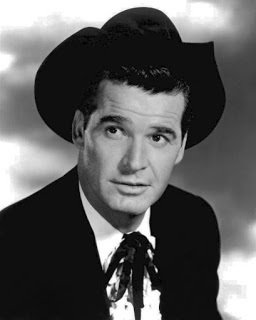

19 July 2014
Death of James Garner, actor
James Garner (born James Scott Bumgarner; April 7, 1928 – July 19, 2014) was an American actor, producer, and voice artist. He starred in several television series over more than 5 decades, including such popular roles as Bret Maverick in the 1950s western comedy series Maverick and Jim Rockford in The Rockford Files, and played leading roles in more than 50 theatrical films, including The Great Escape (1963) with Steve McQueen, Paddy Chayefsky's The Americanization of Emily (1964), Grand Prix (1966), Blake Edwards' Victor Victoria (1982), Murphy's Romance (1985), for which he received an Academy Award nomination, Space Cowboys (2000) with Clint Eastwood, and The Notebook (2004).


Published on July 18, 2016 01:45
On this day in history 18 July 452 Atilla the Hun destroys Aquileia
On this day in history
18 July 452
Atilla the Hun destroys Aquileia
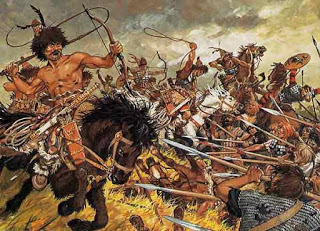
The Sack of Aquileia occurred in 452, and was carried out by the Huns under the leadership of Attila.
A year after Attila's defeat at the Battle of Catalaunian Fields, Attila launched an invasion of Italy, passing through Pannonia into Venetia, where he laid siege to Aquileia. Jordanes states that the city was well defended, to the point where Attila was considering withdrawing. Indeed, Ian Hughes suggests that since Aetius was unable to blockade the Julian Alps, he instead reinforced the city garrison to force Attila into a siege, or otherwise risk Roman forces cutting off his potential retreat. The siege lasted for some time, and Jordanes states that as Attila was considering withdrawing, the city fell in a renewed assault and he razed it to the ground. Attila then proceeded to raid Italy, with Aetius able to do little more than harass Attila at best. It was only when an embassy including Pope Leo I arrived that Attila finally ended his invasion, likely as a result of famine, disease, and an Eastern Roman Army approaching the Hunnic settlements near the Tisza.
Before its destruction, Aquileia was a center of government (with an imperial residence), commerce and finance (with a mint), military defense, and Christianity (with a bishop).Its destruction and Attila's subsequent unimpeded ravaging of the province of Venetia (modern Veneto and Friuli) paved the way for the rise of Venice, which within a few centuries replaced and even surpassed it in importance.

18 July 452
Atilla the Hun destroys Aquileia

The Sack of Aquileia occurred in 452, and was carried out by the Huns under the leadership of Attila.
A year after Attila's defeat at the Battle of Catalaunian Fields, Attila launched an invasion of Italy, passing through Pannonia into Venetia, where he laid siege to Aquileia. Jordanes states that the city was well defended, to the point where Attila was considering withdrawing. Indeed, Ian Hughes suggests that since Aetius was unable to blockade the Julian Alps, he instead reinforced the city garrison to force Attila into a siege, or otherwise risk Roman forces cutting off his potential retreat. The siege lasted for some time, and Jordanes states that as Attila was considering withdrawing, the city fell in a renewed assault and he razed it to the ground. Attila then proceeded to raid Italy, with Aetius able to do little more than harass Attila at best. It was only when an embassy including Pope Leo I arrived that Attila finally ended his invasion, likely as a result of famine, disease, and an Eastern Roman Army approaching the Hunnic settlements near the Tisza.
Before its destruction, Aquileia was a center of government (with an imperial residence), commerce and finance (with a mint), military defense, and Christianity (with a bishop).Its destruction and Attila's subsequent unimpeded ravaging of the province of Venetia (modern Veneto and Friuli) paved the way for the rise of Venice, which within a few centuries replaced and even surpassed it in importance.

Published on July 18, 2016 01:42
July 16, 2016
On this day in history 16 July 1054 Start of the Great Schism in Christendom
On this day in history
16 July 1054
Start of the Great Schism in Christendom
The East–West Schism, also called the Great Schism and the Schism of 1054, was the break of communion between what are now the Eastern Orthodox and Catholic churches, which began in the 11th century and remains to the present day.
The ecclesiastical differences and theological disputes between the Greek East and Latin West pre-existed the formal rupture that occurred in 1054. Prominent among these were the issues of the source of the Holy Spirit, whether leavened or unleavened bread should be used in the Eucharist, the Bishop of Rome's claim to universal jurisdiction, and the place of the See of Constantinople in relation to the Pentarchy.
In 1053, the first step was taken in the process which led to formal schism: the Ecumenical Patriarch of Constantinople Michael I Cerularius ordered the closure of all Latin churches in Constantinople, in response to the Greek churches in southern Italy having been forced to either close or conform to Latin practices. According to the historian J. B. Bury, Cerularius' purpose in closing the Latin churches was "to cut short any attempt at conciliation".
In 1054, the papal legate sent by Leo IX traveled to Constantinople for purposes that included refusing to Cerularius the title of "Ecumenical Patriarch" and insisting that he recognize the Pope's claim to be the head of all the churches. The main purpose of the papal legation was to seek help from the Byzantine Emperor in view of the Norman conquest of southern Italy and to deal with recent attacks by Leo of Ohrid against the use of unleavened bread and other Western customs, attacks that had the support of Cerularius. Historian Axel Bayer says the legation was sent in response to two letters, one from the Emperor seeking assistance in arranging a common military campaign by the eastern and western empires against the Normans, and the other from Cerularius. On the refusal of Cerularius to accept the demand, the leader of the legation, Cardinal Humbert of Silva Candida, O.S.B., excommunicated him by placing the Papal bull of Excommunication on the altar of Hagia Sophia during Saturday afternoon divine liturgy. In return Cerularius excommunicated Humbert and the other legates. This is generally recognised as marking the split between the Catholic and Orthodox traditions in Christianity.
The validity of the Western legates' act is doubtful, since Leo had died and Cerularius' excommunication applied only to the legates personally. Still, the Church split along doctrinal, theological, linguistic, political, and geographical lines, and the fundamental breach has never been healed, with each side sometimes accusing the other of having fallen into heresy and of having initiated the division. The Crusades, the Massacre of the Latins in 1182, the West's retaliation in the Sacking of Thessalonica in 1185, the capture and Siege of Constantinople in 1204, and the imposition of Latin patriarchs made reconciliation more difficult. Establishing Latin hierarchies in the Crusader states meant that there were two rival claimants to each of the patriarchal sees of Antioch, Constantinople, and Jerusalem, making the existence of schism clear.
Several attempts at reconciliation did not bear fruit. In 1965, Pope Paul VI and the Ecumenical Patriarch of Constantinople Athenagoras I nullified the anathemas of 1054, although this nullification of measures taken against a few individuals was essentially a goodwill gesture and did not constitute any sort of reunion. Contacts between the two sides continue: every year a delegation from each joins in the other's celebration of its patronal feast, Saints Peter and Paul (29 June) for Rome and Saint Andrew (30 November) for Constantinople, and there have been a number of visits by the head of each to the other. The efforts of the Ecumenical Patriarchs towards reconciliation with the Catholic Church have often been the target of sharp criticism from some fellow Orthodox
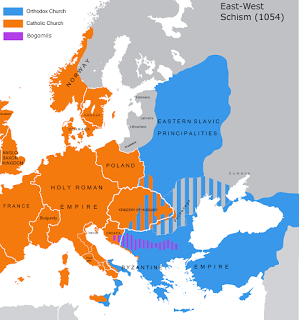

16 July 1054
Start of the Great Schism in Christendom
The East–West Schism, also called the Great Schism and the Schism of 1054, was the break of communion between what are now the Eastern Orthodox and Catholic churches, which began in the 11th century and remains to the present day.
The ecclesiastical differences and theological disputes between the Greek East and Latin West pre-existed the formal rupture that occurred in 1054. Prominent among these were the issues of the source of the Holy Spirit, whether leavened or unleavened bread should be used in the Eucharist, the Bishop of Rome's claim to universal jurisdiction, and the place of the See of Constantinople in relation to the Pentarchy.
In 1053, the first step was taken in the process which led to formal schism: the Ecumenical Patriarch of Constantinople Michael I Cerularius ordered the closure of all Latin churches in Constantinople, in response to the Greek churches in southern Italy having been forced to either close or conform to Latin practices. According to the historian J. B. Bury, Cerularius' purpose in closing the Latin churches was "to cut short any attempt at conciliation".
In 1054, the papal legate sent by Leo IX traveled to Constantinople for purposes that included refusing to Cerularius the title of "Ecumenical Patriarch" and insisting that he recognize the Pope's claim to be the head of all the churches. The main purpose of the papal legation was to seek help from the Byzantine Emperor in view of the Norman conquest of southern Italy and to deal with recent attacks by Leo of Ohrid against the use of unleavened bread and other Western customs, attacks that had the support of Cerularius. Historian Axel Bayer says the legation was sent in response to two letters, one from the Emperor seeking assistance in arranging a common military campaign by the eastern and western empires against the Normans, and the other from Cerularius. On the refusal of Cerularius to accept the demand, the leader of the legation, Cardinal Humbert of Silva Candida, O.S.B., excommunicated him by placing the Papal bull of Excommunication on the altar of Hagia Sophia during Saturday afternoon divine liturgy. In return Cerularius excommunicated Humbert and the other legates. This is generally recognised as marking the split between the Catholic and Orthodox traditions in Christianity.
The validity of the Western legates' act is doubtful, since Leo had died and Cerularius' excommunication applied only to the legates personally. Still, the Church split along doctrinal, theological, linguistic, political, and geographical lines, and the fundamental breach has never been healed, with each side sometimes accusing the other of having fallen into heresy and of having initiated the division. The Crusades, the Massacre of the Latins in 1182, the West's retaliation in the Sacking of Thessalonica in 1185, the capture and Siege of Constantinople in 1204, and the imposition of Latin patriarchs made reconciliation more difficult. Establishing Latin hierarchies in the Crusader states meant that there were two rival claimants to each of the patriarchal sees of Antioch, Constantinople, and Jerusalem, making the existence of schism clear.
Several attempts at reconciliation did not bear fruit. In 1965, Pope Paul VI and the Ecumenical Patriarch of Constantinople Athenagoras I nullified the anathemas of 1054, although this nullification of measures taken against a few individuals was essentially a goodwill gesture and did not constitute any sort of reunion. Contacts between the two sides continue: every year a delegation from each joins in the other's celebration of its patronal feast, Saints Peter and Paul (29 June) for Rome and Saint Andrew (30 November) for Constantinople, and there have been a number of visits by the head of each to the other. The efforts of the Ecumenical Patriarchs towards reconciliation with the Catholic Church have often been the target of sharp criticism from some fellow Orthodox


Published on July 16, 2016 00:00
July 14, 2016
On This Day in History 14 July 1911 birth of Terry Thomas, actor
On This Day in History
14 July 1911 birth of Terry Thomas, actor
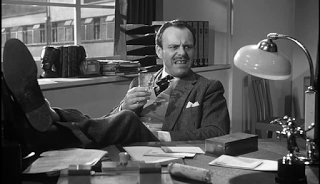
Terry-Thomas (born Thomas Terry Hoar Stevens; 10 July 1911 – 8 January 1990) was an English comedian and character actor who became known to a worldwide audience through his many films during the 1950s and 1960s. He often portrayed disreputable members of the upper classes, especially cads, toffs and bounders, using his distinctive voice; his costume and props tended to include a monocle, waistcoat and cigarette holder. His striking dress sense was set off by a 1⁄3-inch (8.5 mm) gap between his two upper front teeth.
Born in London, Terry-Thomas made his film debut, uncredited, in The Private Life of Henry VIII (1933). He spent several years appearing in smaller roles, before wartime service with Entertainments National Service Association (ENSA) and Stars in Battledress. The experience helped sharpen his cabaret and revue act, increased his public profile and proved instrumental in the development of his successful comic stage routine. Upon his demobilisation, he starred in Piccadilly Hayride on the London stage and was the star of the first comedy series on British television, How Do You View? (1949). He appeared on various BBC radio shows, and made a successful transition into British films. His most creative period was the 1950s when he appeared in Private's Progress (1956), The Green Man (1956), Blue Murder at St Trinian's (1957), I'm All Right Jack (1959) and Carlton-Browne of the F.O. (1959).
From the early 1960s Terry-Thomas began appearing in American films, coarsening his already unsubtle screen character in films such as Bachelor Flat, It's a Mad, Mad, Mad, Mad World and How to Murder Your Wife. From the mid-1960s he frequently starred in European films, in roles such as Sir Reginald in the successful French film La Grande Vadrouille. In 1971 Terry-Thomas was diagnosed with Parkinson's disease, which slowly brought his career to a conclusion: his last film role was in 1980. He spent much of his fortune on medical treatment and, shortly before his death, was living in poverty, existing on charity from the Actors' Benevolent Fund. A charity gala was held in his honour, which raised sufficient funds for him to live his remaining time in a nursing home.


14 July 1911 birth of Terry Thomas, actor

Terry-Thomas (born Thomas Terry Hoar Stevens; 10 July 1911 – 8 January 1990) was an English comedian and character actor who became known to a worldwide audience through his many films during the 1950s and 1960s. He often portrayed disreputable members of the upper classes, especially cads, toffs and bounders, using his distinctive voice; his costume and props tended to include a monocle, waistcoat and cigarette holder. His striking dress sense was set off by a 1⁄3-inch (8.5 mm) gap between his two upper front teeth.
Born in London, Terry-Thomas made his film debut, uncredited, in The Private Life of Henry VIII (1933). He spent several years appearing in smaller roles, before wartime service with Entertainments National Service Association (ENSA) and Stars in Battledress. The experience helped sharpen his cabaret and revue act, increased his public profile and proved instrumental in the development of his successful comic stage routine. Upon his demobilisation, he starred in Piccadilly Hayride on the London stage and was the star of the first comedy series on British television, How Do You View? (1949). He appeared on various BBC radio shows, and made a successful transition into British films. His most creative period was the 1950s when he appeared in Private's Progress (1956), The Green Man (1956), Blue Murder at St Trinian's (1957), I'm All Right Jack (1959) and Carlton-Browne of the F.O. (1959).
From the early 1960s Terry-Thomas began appearing in American films, coarsening his already unsubtle screen character in films such as Bachelor Flat, It's a Mad, Mad, Mad, Mad World and How to Murder Your Wife. From the mid-1960s he frequently starred in European films, in roles such as Sir Reginald in the successful French film La Grande Vadrouille. In 1971 Terry-Thomas was diagnosed with Parkinson's disease, which slowly brought his career to a conclusion: his last film role was in 1980. He spent much of his fortune on medical treatment and, shortly before his death, was living in poverty, existing on charity from the Actors' Benevolent Fund. A charity gala was held in his honour, which raised sufficient funds for him to live his remaining time in a nursing home.


Published on July 14, 2016 01:01



